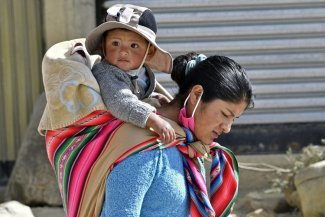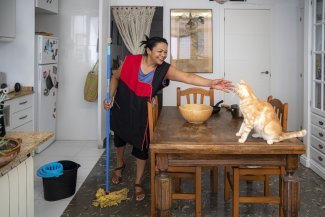Social actors are mobilising to set up a comprehensive care system including centres for child and adolescent care, a measure that would allow parents to work, study and seek employment. In this image, schoolchildren in Buenos Aires attend an extracurricular activity by school bus.
Last May, a draft law was presented to the National Congress of Argentina for the creation of the Integral System of Care Policies of Argentina (SINCA). Drawn up by the Ministry of Women, Gender and Diversity (MMGyD) together with the Ministry of Labour, Employment and Social Security, the bill’s most notable measures include an increase in leave for “pregnant, non-pregnant and adopting workers.” If it passes, the law would increase maternity leave from 90 to 126 days, while paternity (or non-pregnant) leave would initially increase from 2 to 15 days, and continue gradually increasing to reach 90 days.
“We support reforming leave regimes and building a comprehensive care system, although at the moment it doesn’t seem to be a priority for the various political forces in Parliament,” says Yamile Socolovsky of the Central de Trabajadores de la Argentina (CTA). Alejandra Angriman of the Central de Trabajadores de la Argentina Autónoma (CTA-A) adds that the focus should be on financing and predicts that the country’s “heavy indebtedness and the payment of foreign debt could hinder the expansion of comprehensive care policies. Unfortunately, the budget approved by the National Congress does not take this troubling situation into account.”
What is certain is that the country’s current dismal economic situation is contributing to an increase in the gender gap. “We are currently experiencing significant setbacks for women. Many are no longer looking for jobs or are looking to teleworking as their only employment possibility,” says Noemí Ruiz, secretary for Equality and Gender at the Confederación General del Trabajo de la República Argentina (CGTRA).
According to a report by the National Institute of Statistics and Census (INDEC) from the beginning of this year, labour participation is 68.6 per cent for men, compared with 50.2 per cent for women. Against a backdrop of inflation and economic crisis, the situation for women has only gotten worse since the beginning of the pandemic. According to INDEC data for the second half of 2021, 37.3 per cent of the Argentinian population lives below the poverty line. Furthermore, “women are over-represented in the impoverished sectors who have not regained their jobs since the pandemic,” says Natalia Quiroga Díaz, a lecturer specialising in feminist economics at the National University of General Sarmiento (UNGS) of Buenos Aires. The feminisation of poverty is in large part due to the fact that in Argentina and throughout Latin America, women continue to be responsible for raising children and caring for dependents. According to a 2020 report, 75.7 per cent of all domestic and care work is performed by women.
Without adequate care infrastructure, balancing work and parenting becomes a challenge.
While Argentina has a network of public nursery schools (for ages ranging from 45 days to 2 years) and kindergartens (from 3 to 5 years), “there is a major shortage,” especially before the age of four, and as Angriman explains, these centres are unevenly distributed across the country and often only cover four hours a day. As she explains, “only 20 per cent of the population” can afford private daycare.
“Getting your child into a daycare facility is like winning the lottery,” says Lorena (not her real name), a Colombian resident of Buenos Aires and mother of a nine-month-old baby, who is currently trying to find a job and rejoin the labour market after her maternity leave. “My partner and I don’t have enough money, but looking for a job is in itself a job, and with a baby it’s really difficult to sit down at the computer to put together a CV and look for job offers,” she explains. However, like many mothers in her position, Lorena is not considering leaving her child in a nursery for eight or ten hours a day, Monday through Friday. “For now, I’m only considering part-time work, or fully or partially teleworking. But I would really need a space where my daughter can be cared for, where I could also sit and work or check in on her, where my partner could do the same,” she says.
Verónica (who also preferred not to give her real name), a mother of two children, ages nine and two, who is trying to combine motherhood with studying Sociology at the University of Buenos Aires (UBA), makes similar reflections. “It’s not about just dumping the kids somewhere for eight hours, it’s about being near them, being able to help them, for both the mother and father. I’ve always hoped for a nursery within the Faculty of Social Sciences. This would allow me to continue with my classes and and breastfeed,” says Veronica. “There have been several attempts to create one, but none have been successful.”
Teleworking and the invisibilisation of care work
The pandemic reinforced the idea that mothers can reconcile care and work life if they work from home: “People believed that women could simply telework while providing care. I think this is based on the idea that caregiving is not work, that it doesn’t require attention. There is an invisibilisation of domestic and care work that has everything to do with the gender gap, with the expropriation of women’s work,” says Verónica.
However, contrary to the prevailing view, care work is demanding and requires attention. This is Lorena’s dilemma: “If I get a job that I can do from home, I would need to hire a nanny to be able to work, which is only possible because I receive extra income from rent. The income from our work alone wouldn’t be enough for us. But this is exactly what perpetuates the precariousness of care workers, because to make ends meet with my salary, I have to pay a pittance to the person who is looking after the love of my life.”
“Rather than universal systems of care, what we have is a chain of precariousness, with some women paying other women what they can to care for their children,” explains Natalia Quiroga. “The problem with teleworking as an option for women who care for their children is that it leads to the privatisation of a public problem. It is urgent that we stop thinking of care as a female problem.”
The right to care and be cared for
CGTRA is working on drafting an alternative bill that focuses on the creation of “inclusive assistance and comprehensive protection centres for early childhood, childhood and adolescence, for the children of workers, whether formal, underemployed or unemployed,” which includes coverage for people looking for work and studying, like Lorena and Veronica. As Noemí Ruiz explains, the draft bill is based on the concept of “care as a right, both the right to give care and the right to receive care.” The bill proposes comprehensive centres aimed at the education, health and nutrition of children and adolescents:
“We are committed to the professionalisation of care, that’s why one of the central objectives is training in all the tasks involved, teachers, doctors, caretakers, etc.,” she explains.
According to Ruiz, this law would not only strengthen the rights of caregivers but would also generate thousands of quality jobs and contribute to economic recovery. “We can view these care infrastructures as spaces for economic recovery. A central element is to recover the space of the public sphere, of social and popular economies, organised in networks to guarantee the complexity of care work, especially for children. This implies that the state takes responsibility for care and makes a radical commitment to a better future for the new generations,” says Quiroga Díaz. The CTA also demands “the recognition of care work as a job that should be professionalised, remunerated and formalised,” says Socolovsky.
“Public policies should aim to modify the responsibility for care that falls excessively on households, particularly on women and feminised bodies, by making states, companies and social organisations more responsible,” says Angriman. Drawing on her own experience, Veronica sums it up: “It isn’t enough to talk about the co-responsibility of parents or extended families, society needs to take responsibility and collectivise care. But for society to be involved, it has to be seen as something necessary and relevant.”













